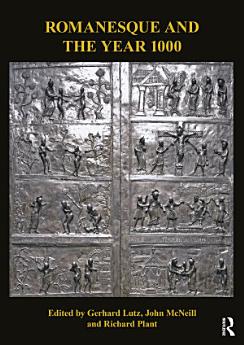Romanesque and the Year 1000
About this ebook
Despite the complex political situation in late 10th-century Europe – a period marked by chaos in some areas and the effective exercise of authority in others – the last quarter of the century saw an apparent upsurge in artistic production in the Empire, southern Britain, Lombardy, the Alps, and the Mediterranean, albeit one whose survival rate is low. The decades after the millennium have left a larger residue of work, notably in France, Catalonia and northern Italy, but were the 1020s artistically more dynamic than the 980s? How might we describe the cultural climate of the Latin West between c. 970 and c. 1030? Individual chapters examine the influence of Carolingian art on artistic production around 1000; the emergence of new approaches to architecture in France, Germany, England and northern Italy; and the response of artists to perceived order and disorder at the turn of the millennium. There are studies of architectural sculpture in Catalonia and Castile, new town foundation in Saxony, and monastic architecture in southern Britain, together with examinations of Ottonian sarcophagi, book covers in gold and ivory, the wall-paintings at Reichenau, the patronage of Willigis at Mainz and Robert the Pious in northern France, the early Romanesque of Poland and Hungary, and the reflection of a new type of affective piety in the manuscript illumination of late Anglo-Saxon England.
Romanesque and the Year 1000 presents a wealth of new research in artistic production at a critical period and is of interest to art historians, archaeologists, and historians alike.
About the author
Gerhard Lutz is the Robert P. Bergman Curator of Medieval Art at the Cleveland Museum of Art. Prior to this he was Curator and Associate Director at the Dom-Museum, Hildesheim (2009 –20). He has taught at the Technische Universität Dresden (2001–08), the Institute of Fine Arts, New York University, the University of Bern and, since 2021, at the Case Western Reserve University in Cleveland. He is a member of the Board of Directors of the ICMA, and is co-founder of the biennial conference series Forum Medieval Art. His publications are concerned with medieval sculpture and metalwork; he was co-editor of Christ on the Cross: The Boston Crucifix and the Rise of Monumental Wood Sculpture 970–1200 (2020) and was editor of Riemenschneider and Late Medieval Alabaster (2023).
John McNeill taught at Oxford University’s Department of Continuing Education and was Secretary of the British Archaeological Association, for whom he edited and contributed to volumes on Anjou, King’s Lynn and the Fens, the medieval cloister, and English medieval chantries. He was instrumental in establishing the BAA’s International Romanesque Conference Series and published widely on medieval architecture and architectural sculpture, particularly that associated with monastic precincts.
Richard Plant has taught at a number of institutions and worked for many years at Christie’s Education in London, where he was deputy academic director. His research interests lie in the buildings of the Anglo-Norman realm and the Holy Roman Empire, in particular in architectural iconography. He is Publicity Officer for the British Archaeological Association, and in addition to this volume, he co-edited Romanesque and the Past (2013), Romanesque Patrons and Processes (2018), Romanesque Saints, Shrines and Pilgrimage (2020), and The Regional and Transregional in Romanesque (2021).






